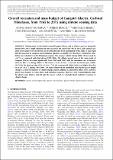Files in this item
Overall recession and mass budget of Gangotri Glacier, Garhwal Himalayas, from 1965 to 2015 using remote sensing data
Item metadata
| dc.contributor.author | Bhattacharya, Atanu | |
| dc.contributor.author | Bolch, Tobias | |
| dc.contributor.author | Mukherjee, Kriti | |
| dc.contributor.author | Pieczonka, Tino | |
| dc.contributor.author | Kropacek, Jan | |
| dc.contributor.author | Buchroithner, Manfred F. | |
| dc.date.accessioned | 2019-03-13T15:30:10Z | |
| dc.date.available | 2019-03-13T15:30:10Z | |
| dc.date.issued | 2016-12 | |
| dc.identifier | 258136574 | |
| dc.identifier | b16879c7-201e-4fce-909d-30bd278186a2 | |
| dc.identifier | 84995532870 | |
| dc.identifier | 000389173500012 | |
| dc.identifier.citation | Bhattacharya , A , Bolch , T , Mukherjee , K , Pieczonka , T , Kropacek , J & Buchroithner , M F 2016 , ' Overall recession and mass budget of Gangotri Glacier, Garhwal Himalayas, from 1965 to 2015 using remote sensing data ' , Journal of Glaciology , vol. 62 , no. 236 , pp. 1115-1133 . https://doi.org/10.1017/jog.2016.96 , https://doi.org/10.1017/jog.2016.96 | en |
| dc.identifier.issn | 0022-1430 | |
| dc.identifier.other | ORCID: /0000-0002-8201-5059/work/55379167 | |
| dc.identifier.uri | https://hdl.handle.net/10023/17279 | |
| dc.description.abstract | Thinning rates for the debris-covered Gangotri Glacier and its tributary glaciers during the period 1968-2014, length variation and area vacated at the snout from 1965 to 2015, and seasonal variation of ice-surface velocity for the last two decades have been investigated in this study. It was found that the mass loss of Gangotri and its tributary glaciers was slightly less than those reported for other debris-covered glaciers in the Himalayan regions. The average velocity during 2006-14 decreased by ~6.7% as compared with that during 1993-2006. The debris-covered area of the main trunk of Gangotri Glacier increased significantly from 1965 until 2015 with the maximum rate of increase (0.8 ± 0.2 km2 a-1) during 2006-15. The retreat (~9.0 ± 3.5 m a-1) was less in recent years (2006-2015) but the down-wasting (0.34 ± 0.2 m a-1) in the same period (2006-2014) was higher than that (0.20 ± 0.1 m a-1) during 1968-2006. The study reinforced the established fact that the glacier length change is a delayed response to climate change and, in addition, is affected by debris cover, whereas glacier mass balance is a more direct and immediate response. Therefore, it is recommended to study the glacier mass balance and not only the glacier extent, to conclude about a glacier's response to climate change. | |
| dc.format.extent | 19 | |
| dc.format.extent | 1945197 | |
| dc.language.iso | eng | |
| dc.relation.ispartof | Journal of Glaciology | en |
| dc.subject | Corona and hexagon data | en |
| dc.subject | Glacier mass balance | en |
| dc.subject | Glacier retreat | en |
| dc.subject | Glacier surface velocity | en |
| dc.subject | GE Environmental Sciences | en |
| dc.subject | Earth-Surface Processes | en |
| dc.subject | 3rd-DAS | en |
| dc.subject | SDG 13 - Climate Action | en |
| dc.subject.lcc | GE | en |
| dc.title | Overall recession and mass budget of Gangotri Glacier, Garhwal Himalayas, from 1965 to 2015 using remote sensing data | en |
| dc.type | Journal article | en |
| dc.contributor.institution | University of St Andrews. School of Geography & Sustainable Development | en |
| dc.contributor.institution | University of St Andrews. Bell-Edwards Geographic Data Institute | en |
| dc.identifier.doi | 10.1017/jog.2016.96 | |
| dc.description.status | Peer reviewed | en |
This item appears in the following Collection(s)
Items in the St Andrews Research Repository are protected by copyright, with all rights reserved, unless otherwise indicated.

